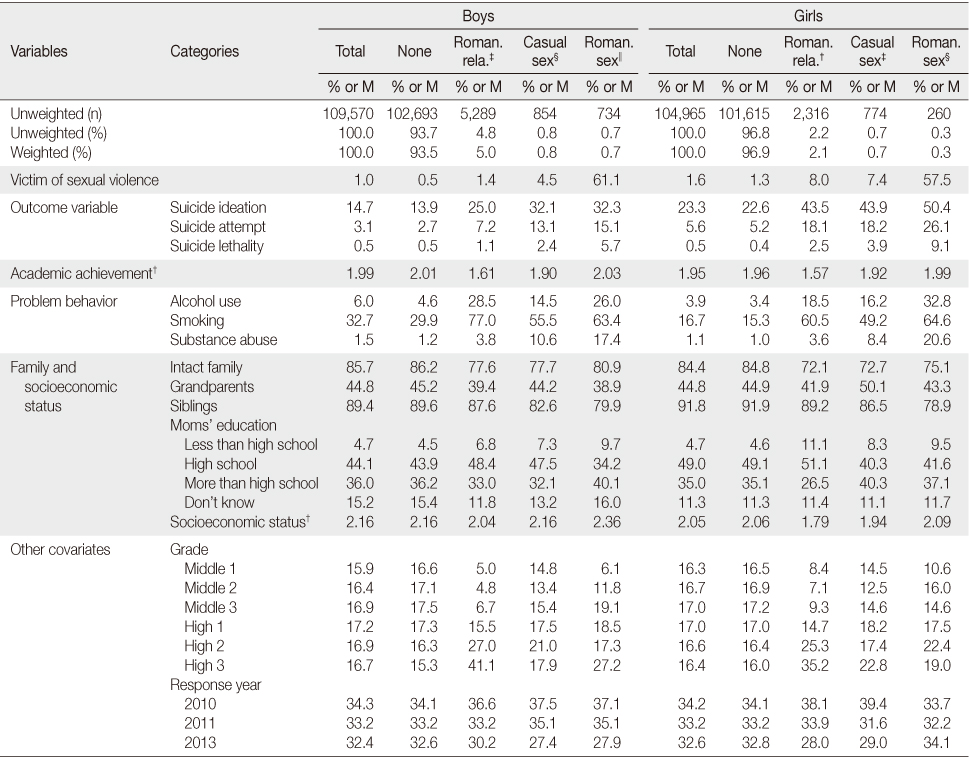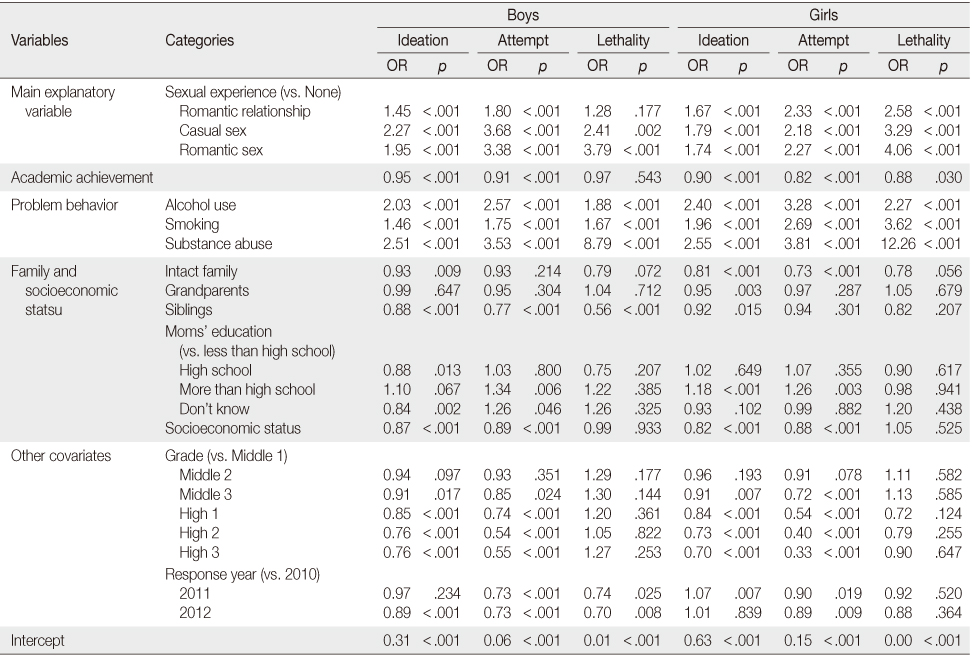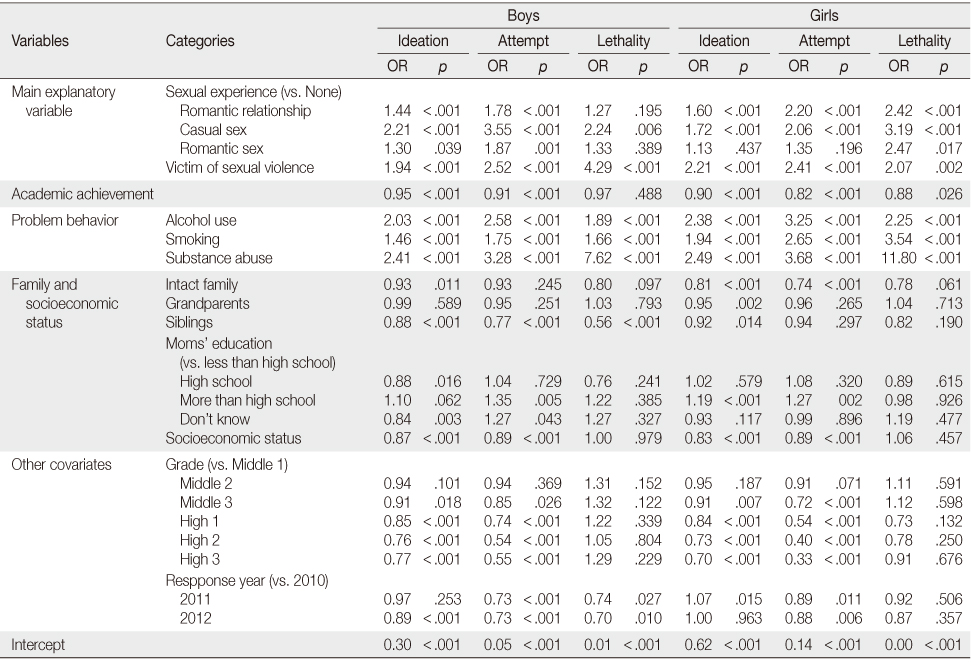Articles
- Page Path
- HOME > J Korean Acad Nurs > Volume 45(2); 2015 > Article
-
Original Article
- Effects of Sexual Intercourse on Suicidal Behaviors among Adolescents in South Korea
- Hyun Sik Kim
-
Journal of Korean Academy of Nursing 2015;45(2):183-191.
DOI: https://doi.org/10.4040/jkan.2015.45.2.183
Published online: April 30, 2015
Department of Sociology, Kyung Hee University, Seoul, Korea.
- Address reprint requests to: Kim, Hyun Sik. Department of Sociology, Kyung Hee University, 26 Kyungheedae-ro, Dongdaemun-gu, Seoul 130-701, Korea. Tel: +82-2-961-0806, Fax: +82-2-961-0622, sochyunsik@khu.ac.kr
© 2015 Korean Society of Nursing Science
This is an Open Access article distributed under the terms of the Creative Commons Attribution NoDerivs License. (http://creativecommons.org/licenses/by-nd/4.0/) If the original work is properly cited and retained without any modification or reproduction, it can be used and re-distributed in any format and medium.
Abstract
-
Purpose
- For the current article an examination was done as to whether engaging in sexual intercourse before or during adolescence has a negative impact on the suicidal behaviors of suicide ideation, suicide attempt, and suicide lethality and whether the impact varies according to the context of sexual intercourse and/or gender.
-
Methods
- Adolescents who experienced casual sex and romantic sex were compared to adolescents who retained their virginity. Data was from samples drawn from the three waves (2010~2012) of the Korea Youth Risk Behavior Web-Based Survey. Logistic models were used to adjust for a wide array of confounding variables.
-
Results
- Any type of sexual intercourse increases risk of all suicidal behaviors. Sexual intercourse in a romantic relationship exhibits enhanced risk of suicidal behaviors compared to casual sex. Adjusting for experience of sexual violence, however, decreases risk of romantic sex substantially, turning some estimates statistically insignificant. In addition, risks for suicide lethality are greater for girls than boys.
-
Conclusion
- Romantic sex put adolescents at higher risk for suicidal behaviors than casual sex owing to prevalent sexual violence in the relationships. Girls suffer more substantively adverse outcomes than boys. These results suggest that adolescents will benefit from comprehensive education on sexuality and sexual behaviors regarding how to form and maintain a romantic relationship that is characterized by personal integrity and mutual respect. It is also important to help victims of sexual violence recover from traumatic events by providing emotional support and effective counseling.
- 1. Rector R, Johnson KA, Noyes LR. Sexually active teenagers are more likely to be depressed and to attempt suicide [Internet]. Washington, DC, The Heritage Foundation. 2003;cited 2014 April 10. Available from: http://www.heritage.org/research/reports/2003/06/sexually-active-teenagers-are-more-likely-to-be-depressed
- 2. Hallfors DD, Waller MW, Ford CA, Halpern CT, Brodish PH, Iritani B. Adolescent depression and suicide risk: Association with sex and drug behavior. Am J Prev Med. 2004;27(3):224–231. ArticlePubMed
- 3. Meier A. Adolescent first sex and subsequent mental health. Am J Sociol. 2007;112(8):1811–1847. Article
- 4. Jessor SL, Jessor R. Transition from virginity to nonvirginity among youth: A social-psychological study over time. Dev Psychol. 1975;11(4):473–484.Article
- 5. McCarthy B, Grodsky E. Sex and school: Adolescent sexual intercourse and education. Soc Probl. 2011;58(2):213–234. Article
- 6. Kim DS, Kim HS. Early initiation of alcohol drinking, cigarette smoking, and sexual intercourse linked to suicidal ideation and attempts: Findings from the 2006 Korean youth risk behavior survey. Yonsei Med J. 2010;51(1):18–26. ArticlePubMed
- 7. Park HS, Schepp KG, Jang EH, Koo HY. Predictors of suicidal ideation among high school students by gender in South Korea. J Sch Health. 2006;76(5):181–188. ArticlePubMed
- 8. Kann L, Kinchen S, Shanklin SL, Flint KH, Kawkins J, Harris WA, et al. Youth risk behavior surveillance-United States, 2013. MMWR Surveill Summ. 2014;63:Suppl 4. 1–168.
- 9. Korea Centers for Disease Control and Prevention. The eighth Korea youth risk behavior web-based survey. Seoul: Ministry of Education, Ministry of Health and Welfare, Korea Centers for Disease Control and Prevention; 2012.
- 10. Soller B. Caught in a bad romance: Adolescent romantic relationships and mental health. J Health Soc Behav. 2014;55(1):56–72. ArticlePubMedPDF
- 11. Olshen E, McVeigh KH, Wunsch-Hitzig RA, Rickert VI. Dating violence, sexual assault, and suicide attempts among urban teenagers. Arch Pediatr Adolesc Med. 2007;161(6):539–545. ArticlePubMed
- 12. Yang HW, Shin HS. The prevalence and the predictors of dating violence among high school students. Stud Korea Youth. 2006;17(1):33–59.
- 13. Crawford M, Popp D. Sexual double standards: A review and methodological critique of two decades of research. J Sex Res. 2003;40(1):13–26. ArticlePubMed
- 14. Baek HJ, Kim EJ. Sexuality and sexual behaviors among Korean adolescents. Seoul: National Youth Policy Institute; National Youth Policy Institute.12;Report No.: Research Report 08-R08.
- 15. Spriggs AL, Halpern CT. Sexual debut timing and depressive symptoms in emerging adulthood. J Youth Adolesc. 2008;37(9):1085–1096. ArticlePubMedPMCPDF
- 16. Korea Centers for Disease Control and Prevention. 2012 Korean youth health risk behavior on-line survey. Cheongwon: Ministry of Education, Science and Technology, Ministry of Health & Welfare, Korea Centers for Disease Control and Prevention; 2012.
- 17. Allison PD. Missing data. Thousand Oaks, CA: Sage Publications; 2001.
- 18. Rosenbaum Rosenbaum. Observational studies. 2nd ed. New York, NY: Springer-Verlag; 2002.
- 19. Halpern CT, Joyner K, Udry JR, Suchindran C. Smart teens don't have sex (or kiss much either). J Adolesc Health. 2000;26(3):213–225.ArticlePubMed
- 20. Donovan JE, Jessor R. Structure of problem behavior in adolescence and young adulthood. J Consult Clin Psychol. 1985;53(6):890–904.ArticlePubMed
- 21. Miller BC. Family influences on adolescent sexual and contraceptive behavior. J Sex Res. 2002;39(1):22–26. ArticlePubMed
- 22. Kim KH, Kwon HJ, Chung HK. A study on the variables forecasting male adolescents' sexual intercourse. J Korean Acad Nurs. 2004;34(6):954–963.ArticlePDF
- 23. Lee JH. A study on the variables forecasting female high school students' sexual intercourse. Stud Korea Youth. 2007;18(2):111–131.
- 24. StataCorp. Stata: Release 12. Statistical software. College Station, TX: StataCorp LP; 2011.
- 25. Baek WH. Differences in perceptions of heterosexual romantic relationships between adolescent children and parents, and their conflicts. Korean J Youth Stud. 2011;18(12):29–54.
- 26. Lee YS, Kim EY, Kang SY, Kim LS, Yoo JH, Choi YH, et al. Personal interviews with adolescents who was in dating relationships. Korea Youth Counseling & Welfare Institute. Adolescents' love: Unveiling dating relationships of teenagers. Busan: Korea Youth Counseling & Welfare Institute; 2013. p. 12–73.
- 27. Lee E, Kang JY, Yoon OK, Cho YO, Lee SH. A study on comprehensive plan to protect children and youths from sexual harassment I: How to protect children and youths from sexual violence and support victims. Seoul: National Youth Policy Institute; 2012.12;Report No.: Research Report 12-R13.
- 28. Lee M, Lee IS, Kim KH. A research on improvement of supports for sexual assault victims from case study analysis. Seoul: Korean Women's Development Institute; 2013.10;Report No.: 2013 Research Report 10.
- 29. Yoo YS, Cho OH, Cha KS, Boo YJ. Factors influencing post-traumatic stress in Korean forensic science investigators. Asian Nurs Res (Korean Soc Nurs Sci). 2013;7(3):136–141. ArticlePubMed
REFERENCES
Figure & Data
REFERENCES
Citations

- The Influence of Sexual Experience on Mental Health among Adolescents: A Cross-Sectional Study Based on the Korea Youth Risk Behavior Survey
Kyong Sil Park
Journal of Korean Academy of psychiatric and Mental Health Nursing.2025; 34(2): 129. CrossRef - Factors influencing suicidal ideation among middle school students
Joo Hee Kim
Korean Journal of Health Education and Promotion.2024; 41(5): 37. CrossRef - Trends in Contraceptive Use and Influencing Factors Among Korean Adolescent Girls With Sexual Intercourse Experience (2013 to 2022)
Beomman Ha, Jisoon Kim, Seonho Kim
Journal of Korean Maternal and Child Health.2024; 28(3): 134. CrossRef - Predictors of Suicide Attempt among Middle School Students with Suicidal Ideation: Analysis of Data from the 15th (2019) Korea Youth Risk Behavior Web-based Survey
Hye Jin Lee, Jin Ju Kim
Journal of Korean Academy of psychiatric and Mental Health Nursing.2022; 31(1): 101. CrossRef - Prediction of adolescent suicidal ideation after the COVID-19 pandemic: A nationwide survey of a representative sample of Korea
Haewon Byeon
Frontiers in Pediatrics.2022;[Epub] CrossRef - Factors influencing suicidal tendencies during COVID-19 pandemic in Korean multicultural adolescents: a cross-sectional study
Ju-Young Park, Insook Lee
BMC Psychology.2022;[Epub] CrossRef - The Impact Factors on Mental Health of Male and Female Korean Adolescents - Focusing on Sexual Experience: Analyzing Data from the 11th Korean Youth Risk Behavior Web-Based Survey
Mijung Yeom, Gyungjoo Lee, Ju-Young Lee
Journal of Korean Academy of psychiatric and Mental Health Nursing.2020; 29(3): 195. CrossRef - Suicidal Behaviors of Culturally Diverse Adolescents with Sexual Experience: Using Date from the 10~12th Korean Youth Risk Behavior Web-based Survey
Hyun Jung Lee, Gyungjoo Lee
Journal of Korean Academy of Psychiatric and Mental Health Nursing.2019; 28(3): 205. CrossRef - Association between sexual behavior and suicidal ideation among South Korean middle school students
Seunghun Song, Gyuyoung Lee
Japan Journal of Nursing Science.2019; 16(3): 300. CrossRef - Influence of Sexual Behavior and Emotional State on Suicidal Ideation among Female Adolescents with Sexual Intercourse Experience
Suin Park, Jina Lee, Hyunlye Kim
Journal of Korean Academy of Psychiatric and Mental Health Nursing.2018; 27(1): 15. CrossRef
Descriptive Statistics by Sexual Experiences*
* Unless otherwise noted, weights ("w") are applied; †Statistics associated with this sign denote mean and the other statistics show percentage of a specific category; ‡Romantic non-sexual relationship; §Casual sexual relationship; ∥Romantic sexual relationship.
Odd Ratios Predicting Suicidal Behaviors before Adjusting for Sexual Violence*
*Weights ("w") are applied.
Odd Ratios Predicting Suicidal Behaviors after Adjusting for Sexual Violence*
*Weights ("w") are applied.
* Unless otherwise noted, weights ("w") are applied; †Statistics associated with this sign denote mean and the other statistics show percentage of a specific category; ‡Romantic non-sexual relationship; §Casual sexual relationship; ∥Romantic sexual relationship.
*Weights ("w") are applied.
*Weights ("w") are applied.
 KSNS
KSNS
 E-SUBMISSION
E-SUBMISSION



 Cite
Cite

